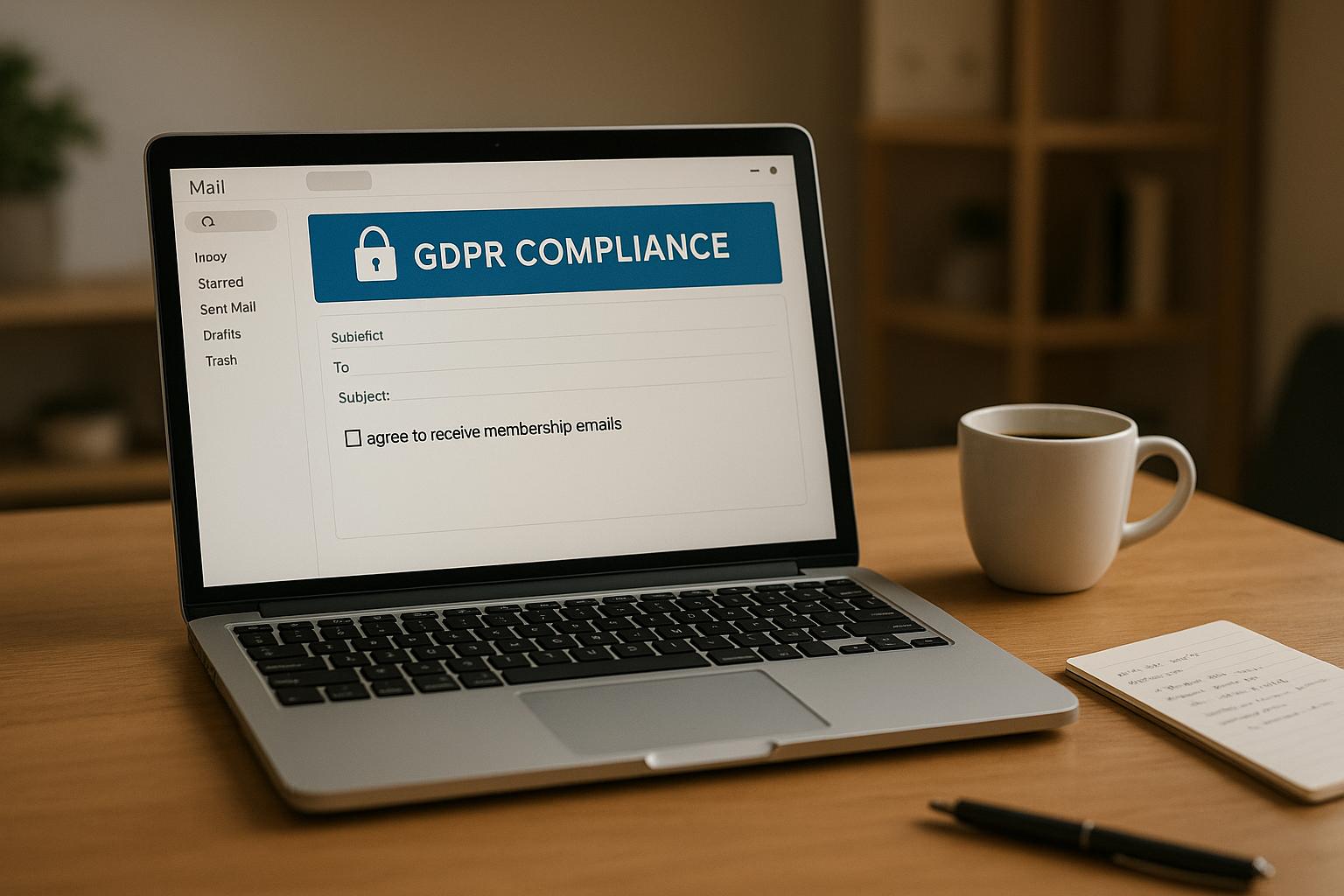GDPR compliance for email marketing is essential if your membership site handles data from EU residents. Here’s what you need to know:
- Consent: Members must actively opt-in to receive your emails (unchecked boxes only).
- Transparency: Clearly explain how data will be used and provide easy ways for members to manage preferences.
- Data Rights: Allow members to access, update, or delete their data anytime.
To comply, use double opt-in, provide clear privacy policies, and keep detailed consent records. GDPR isn’t just about avoiding fines – it builds member trust and improves email campaign quality by targeting genuinely interested users.
| Key GDPR Email Rules | What You Should Do |
|---|---|
| Explicit Consent | Use opt-in checkboxes and verify consent with double opt-in. |
| Data Use Disclosure | Explain how data will be used during signup. |
| Data Rights | Enable access, updates, and deletion for member data. |
Compliance tools like consent tracking systems and automated privacy controls can simplify this process. Focus on respecting member privacy while running effective campaigns.
GDPR Email Marketing Rules for Membership Sites
Who Needs to Follow GDPR Rules
If your membership site handles data from EU residents, you must comply with GDPR. This applies whether you have EU subscribers, offer goods or services to EU customers, track EU visitor data, or store any personal data from EU residents.
Even if only one EU member subscribes, your site must fully adhere to GDPR regulations for email marketing. These rules set the foundation for how you manage email communications under GDPR.
Main GDPR Email Marketing Requirements
The key GDPR requirements for membership email marketing revolve around three main areas:
| Requirement | Description | Implementation |
|---|---|---|
| Explicit Consent | Members must actively opt-in to receive emails | Use unchecked checkboxes to ensure active opt-in |
| Clear Data Use Disclosure | Clearly explain how data will be used | Provide transparent privacy notices at signup |
| Data Access Rights | Members can request their data or deletion | Enable options for data export and deletion |
These practices help protect your members’ trust and ensure your email campaigns comply with GDPR.
Consent Rules: You must obtain separate, clear, and revocable consent, detailing the purpose of data collection.
Data Handling Guidelines: Only collect the data you need, store it securely, and keep thorough records of how it’s processed.
Members also have the right to access their data, request corrections, transfer it, or have it deleted.
These rules apply to all types of email marketing, such as:
- Welcome emails
- Newsletters
- Membership updates
- Promotional offers
- Automated email sequences
Steps to Make Your Email Campaigns GDPR Compliant
Getting Clear Member Permission
When creating membership forms, include the following:
- Separate, unchecked opt-in boxes
- A clear explanation of how the data will be used
- Details about email frequency
- A link to your privacy policy
For membership sites, offer detailed consent options so members can select their preferred communication types. Here’s an example:
| Communication Type | Purpose | Key Details to Include |
|---|---|---|
| Welcome Sequence | Onboarding emails | Purpose, frequency, duration |
| Course Updates | Learning materials | Content type, delivery schedule |
| Member News | Site announcements | Scope and timing of updates |
| Marketing Offers | Promotional content | Types of offers, sending frequency |
Once consent is gathered, confirm it through a reliable verification process.
Setting Up Confirmation Emails
Use double opt-in to ensure consent is verified and properly documented. Follow these steps:
- Send a verification email that clearly states its purpose and includes a prominent confirmation link.
- Redirect users to a confirmation page that shows:
- Their selected preferences
- Agreed communication types
- Options to modify preferences
- Confirmation of activation
- After verification, start the welcome sequence. Be sure to:
- Summarize their consent choices
- Provide links to manage preferences
- Include unsubscribe options
This process ensures you have verified consent and creates an audit trail for compliance.
Recording Consent Details
Keep detailed records of consent using the following data points:
| Data Point | Information to Record | Storage Format |
|---|---|---|
| Timestamp | Date and time of consent | ISO 8601 format |
| Source | URL or location of signup | Full webpage path |
| IP Address | IP address at the time of signup | Encrypted string |
| Consent Text | Exact wording shown during signup | Version-controlled copy |
| Selected Options | Permissions granted by the user | Boolean values |
Store these records securely and back them up regularly. Your system should also:
- Track any changes to consent
- Monitor and document withdrawal requests
- Keep a record of communication preferences
- Generate reports to demonstrate compliance
Data Privacy Best Practices for Member Emails
Making Unsubscribe Simple
Ensure your unsubscribe process is straightforward and respects member preferences while staying compliant with GDPR. Include unsubscribe links prominently in every email footer, using clear and visible language. Offer a single-click unsubscribe option that doesn’t require members to:
- Log into their account
- Navigate through multiple pages
- Provide additional information
- Confirm multiple times
Additionally, provide options to customize email preferences:
| Preference Option | Description | Implementation |
|---|---|---|
| Email Frequency | Choose daily, weekly, or monthly updates | Radio button selection |
| Content Types | Select updates, newsletters, or promotions | Checkbox group |
Process unsubscribe requests within 24 hours and send an automatic confirmation email to document the change. A seamless opt-out process reinforces your dedication to respecting member data and preferences.
Collecting Only Required Data
Beyond simplifying unsubscription, limit the data you collect to what’s essential. For email purposes, this typically includes:
- Email address
- First name (for personalization)
- Communication preferences
- Membership level (if relevant for segmentation)
Avoid requesting sensitive information unless absolutely necessary. When importing member lists or merging data from other sources, perform a detailed audit to ensure compliance with privacy regulations.
Keeping Privacy Policies Current
Regularly update your privacy policy to reflect your email marketing practices. Review it quarterly or whenever you make significant changes to how you handle data. Your privacy policy should clearly address:
1. Data Collection and Processing
Explain what information you collect and how it’s used in email marketing, including segmentation, personalization, and any third-party processing.
2. Member Rights
Outline how members can exercise their GDPR rights, such as accessing their data, requesting deletions, updating preferences, downloading their information, or filing complaints.
Keep track of policy updates with version control. Staying current with privacy policies not only ensures GDPR compliance but also builds trust with your members.
sbb-itb-dee25d2
GDPR Compliance Tools and Support
GDPR Management Software Options
Choosing the right tools to handle consent, data, and privacy is critical for staying GDPR-compliant. Below is a breakdown of key features to consider when evaluating GDPR management software:
| Feature Category | Key Components | Purpose |
|---|---|---|
| Consent Management | Double opt-in system, preference center | Track and store member consent records |
| Data Processing | Data encryption, automatic backups | Protect and securely store member information |
| Privacy Controls | Access management, data export tools | Support member data rights |
| Documentation | Audit logs, compliance reports | Maintain accountability for GDPR compliance |
When selecting software, focus on tools that integrate smoothly with your current email marketing platform and automate compliance workflows. Look for features that allow you to:
- Monitor consent statuses across your membership database
- Automatically generate compliance documentation
- Process data subject access requests efficiently
- Keep detailed logs of all data processing activities
These capabilities are especially useful for creating tailored GDPR solutions for WordPress-based environments.
WordPress GDPR Email Solutions
Our WordPress membership solutions come equipped with built-in GDPR compliance features, ensuring your site adheres to privacy regulations while simplifying operations.
1. Consent Management Integration
We provide consent tracking systems that integrate effortlessly with popular membership plugins like MemberPress and WooCommerce Memberships. These systems keep detailed records, including:
- The date and time consent was given
- Specific permissions granted
- Methods used to obtain consent
- Any updates or changes to consent status
2. Automated Privacy Controls
Our WordPress setups include automated tools that help you stay compliant without adding extra complexity:
| Feature | Function | Benefit |
|---|---|---|
| Privacy Policy Generator | Creates updated, compliant policies | Keeps your documentation current |
| Data Export Tool | Produces detailed member data reports | Meets GDPR "right to access" standards |
| Consent Logs | Tracks all changes to permissions | Provides an audit trail for compliance |
3. Email Marketing Integration
We configure WordPress to work seamlessly with your email marketing system while meeting GDPR requirements. Key features include:
- Comprehensive subscription options for members
- Built-in unsubscribe functionality for easy opt-outs
- Secure data transfer protocols to protect sensitive information
These solutions allow you to manage email campaigns efficiently while safeguarding your members’ privacy and ensuring full compliance with GDPR regulations. This approach protects both your organization and the rights of your members.
GDPR compliance in Email Marketing [Step-by-step Checklist …
Conclusion
Complying with GDPR is crucial for membership email marketing. It not only ensures legal protection but also helps build trust with members. By following proper data privacy practices and managing consent effectively, membership sites can meet regulatory standards while fostering stronger relationships with their members.
Here’s a quick look at the advantages of GDPR-compliant email campaigns:
| Benefit | Impact |
|---|---|
| Legal Protection | Reduces the risk of non-compliance issues |
| Member Trust | Boosts engagement with transparent data practices |
| Data Quality | Keeps email lists focused on members who opt in knowingly |
| Campaign Efficiency | Targets members who are genuinely interested |
These points highlight that GDPR compliance isn’t just about following rules – it’s a smart move for membership sites. It shows a commitment to respecting member privacy while improving the effectiveness of email campaigns. Using tools like consent tracking systems, clear privacy policies, and easy-to-use data management features, organizations can run campaigns that respect member rights and achieve their goals.
Remember, GDPR compliance isn’t a one-time task. It requires regular updates and adjustments as email marketing tools and regulations evolve. Staying informed helps protect your organization and your members’ data privacy.
Pro Membership Sites offers solutions designed to meet GDPR standards while strengthening trust and engagement with your members.
FAQs
What happens if membership email campaigns don’t comply with GDPR?
Failing to comply with GDPR in your membership email campaigns can lead to serious consequences. Businesses may face hefty fines – up to €20 million or 4% of their annual global revenue, whichever is higher. Additionally, non-compliance can damage your reputation, erode trust with your members, and result in lost opportunities.
To stay compliant, ensure you have clear, affirmative consent from your members before sending marketing emails. Regularly review your data privacy practices and provide an easy way for users to opt out or manage their preferences. Taking these steps not only keeps you within GDPR guidelines but also builds stronger relationships with your audience.
How can membership sites comply with GDPR when collecting and using member data?
To comply with GDPR, membership sites must prioritize transparency, consent, and data security. First, ensure that members explicitly agree to how their data will be collected, stored, and used. This can be done through clear opt-in forms and detailed privacy policies. Avoid pre-checked boxes for consent, as they are not compliant under GDPR.
Additionally, implement robust measures to protect member data, such as encryption and secure storage. Members should also have the ability to access, update, or delete their information upon request. Regularly review your data practices to ensure ongoing compliance and address any changes in regulations. By following these steps, you can build trust with your members while staying aligned with GDPR requirements.
What features should membership sites look for in GDPR compliance tools to simplify email marketing management?
To ensure GDPR compliance for email campaigns, membership sites should look for tools that offer consent management, data privacy controls, and user-friendly reporting. Key features include the ability to collect and store explicit consent from users, manage opt-ins and opt-outs easily, and provide clear audit trails for regulatory purposes.
Additionally, tools that integrate seamlessly with your email marketing platform can help streamline processes, such as automating consent requests and ensuring only compliant data is used in campaigns. By prioritizing these features, you can focus on building trust with your members while staying compliant with GDPR requirements.





